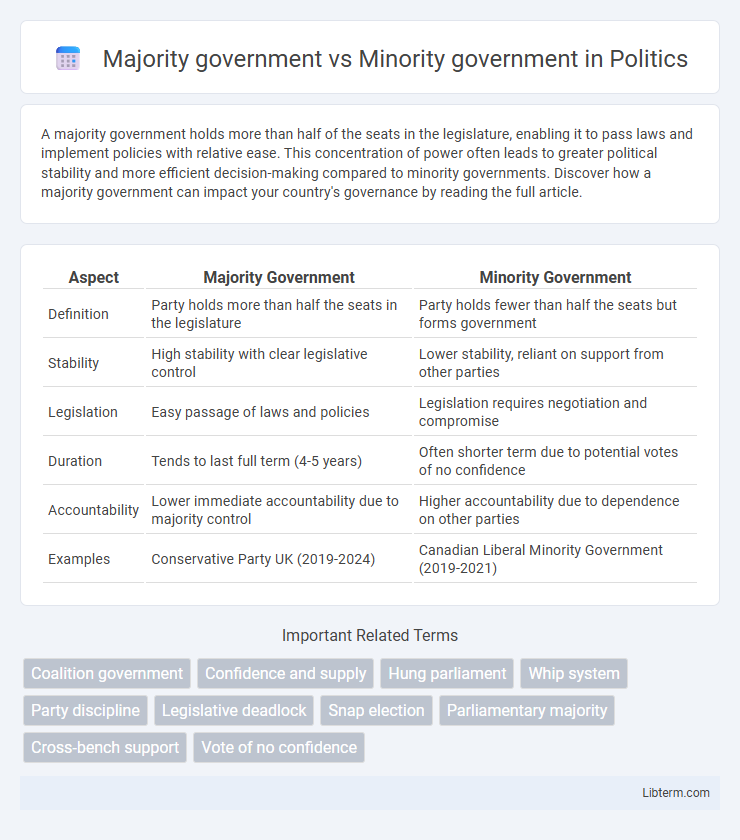A majority government holds more than half of the seats in the legislature, enabling it to pass laws and implement policies with relative ease. This concentration of power often leads to greater political stability and more efficient decision-making compared to minority governments. Discover how a majority government can impact your country's governance by reading the full article.
Table of Comparison
| Aspect | Majority Government | Minority Government |
|---|---|---|
| Definition | Party holds more than half the seats in the legislature | Party holds fewer than half the seats but forms government |
| Stability | High stability with clear legislative control | Lower stability, reliant on support from other parties |
| Legislation | Easy passage of laws and policies | Legislation requires negotiation and compromise |
| Duration | Tends to last full term (4-5 years) | Often shorter term due to potential votes of no confidence |
| Accountability | Lower immediate accountability due to majority control | Higher accountability due to dependence on other parties |
| Examples | Conservative Party UK (2019-2024) | Canadian Liberal Minority Government (2019-2021) |
Understanding Majority and Minority Governments
Majority governments hold more than half the seats in the legislature, enabling them to pass laws and implement policies with greater stability and fewer obstacles. Minority governments, lacking a clear majority, must negotiate with other parties to gain support for legislation, often leading to more compromise and potential instability. Understanding the dynamics between these government types is crucial for analyzing political effectiveness and legislative success.
Key Differences Between Majority and Minority Governments
Majority governments hold more than half the seats in the legislature, ensuring greater stability and the ability to pass legislation without coalition support, whereas minority governments hold fewer than half the seats and must rely on alliances to govern effectively. Majority governments typically experience less legislative gridlock and can implement their policies more efficiently, while minority governments face increased negotiation and compromise challenges. The key difference lies in parliamentary control, with majority governments exerting dominance in decision-making and minority governments navigating precarious power dynamics to maintain confidence.
Formation Process of Each Government Type
Majority government forms when a single party secures more than half the seats in the legislature, allowing it to pass legislation and govern without support from other parties. Minority government arises when no party achieves a majority, requiring the ruling party to negotiate confidence and supply agreements or coalition arrangements to maintain power. The formation process for majority governments is straightforward, relying on election outcomes, whereas minority governments involve complex negotiations to secure enough legislative support.
Advantages of a Majority Government
A majority government holds more than half the seats in the legislature, enabling smoother passage of laws and stable governance without reliance on coalition partners. It ensures consistent policy implementation and reduces the risk of legislative deadlock, fostering efficient decision-making and long-term planning. Political stability from a majority government also attracts investor confidence and strengthens national economic performance.
Challenges Faced by Minority Governments
Minority governments often struggle with legislative instability due to the lack of a clear majority, making it difficult to pass bills without negotiation or support from opposition parties. They face challenges in maintaining confidence and supply, increasing the risk of early elections and political fragmentation. This instability can hinder effective policymaking and long-term governance compared to majority governments, which benefit from more straightforward legislative processes and stronger control over the parliamentary agenda.
Stability and Longevity: Which Is Better?
Majority governments typically provide greater stability and longevity due to their ability to pass legislation and govern without relying on support from other parties, resulting in fewer disruptions and more consistent policy implementation. Minority governments often face challenges in maintaining confidence, leading to frequent negotiations, potential gridlocks, and shorter durations in office. Stability and longevity are generally better ensured under majority governments, making them more effective for sustained governance.
Impact on Policy Making and Legislation
Majority governments typically enable smoother policy making and legislation due to their clear advantage in parliamentary seats, allowing them to pass laws with minimal opposition interference. Minority governments often face challenges in enacting their agendas, requiring negotiation and compromise with opposition parties, which can slow down legislative processes and result in diluted policies. The degree of government stability and policy consistency is generally higher under majority rule, whereas minority governments may experience greater unpredictability and frequent tendering of support deals to maintain power.
Role of Opposition Parties
In a majority government, opposition parties play a critical role in scrutinizing policies and holding the ruling party accountable, often influencing legislation through debate and public pressure. Minority governments face stronger opposition influence, as they rely on smaller parties for confidence and supply, giving opposition groups increased leverage in negotiations and decision-making. The effectiveness of opposition parties in either system significantly impacts democratic governance and policy outcomes.
Historical Examples and Case Studies
Majority governments, such as the UK under Margaret Thatcher (1979-1990), enable stable policy implementation due to clear parliamentary control, while minority governments like Canada's Liberal government (2004-2006) often negotiate support for legislation, resulting in more compromise. The Australian 2010 hung parliament led to a minority government that relied on crossbench alliances to govern, demonstrating the delicate balance required in minority rule. Historical case studies highlight how majority governments facilitate decisive governance, whereas minority governments reflect political flexibility and coalition-building dynamics.
Implications for Democratic Governance
A majority government, holding over half the seats in the legislature, enables stable decision-making and swift policy implementation, enhancing effective democratic governance. Minority governments must negotiate support from other parties, fostering collaboration and compromise but potentially leading to legislative gridlock and policy instability. The balance between efficiency and inclusiveness in majority versus minority governments critically shapes democratic accountability and responsiveness.
Majority government Infographic

 libterm.com
libterm.com